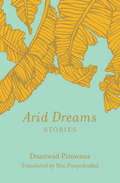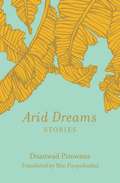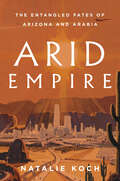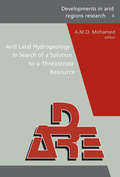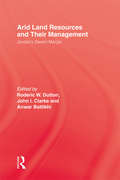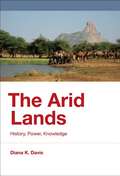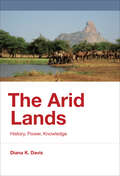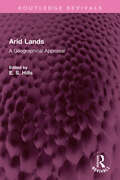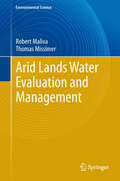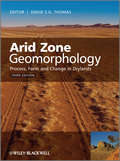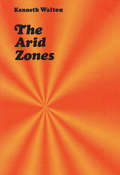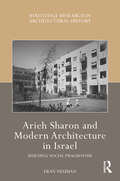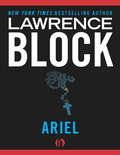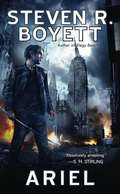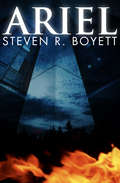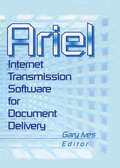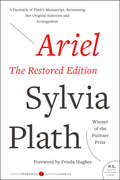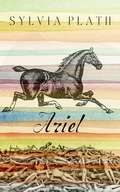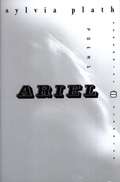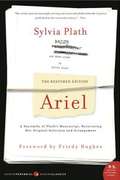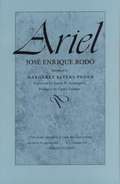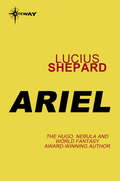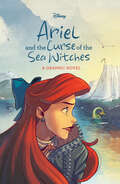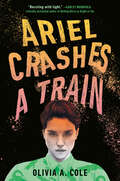- Table View
- List View
Arid Dreams: Stories
by Duanwad Pimwana“One of Thailand’s preeminent female writers . . . Each of her stories poses its own moral challenge, pleasurable and unsettling at once . . . phenomenal.” —NPR.orgIn thirteen stories that investigate ordinary and working-class Thailand, characters aspire for more but remain suspended in routine. They bide their time, waiting for an extraordinary event to end their stasis. A politician’s wife imagines her life had her husband’s accident been fatal, a man on death row requests that a friend clear up a misunderstanding with a sex worker, and an elevator attendant feels himself wasting away while trapped, immobile, at his station all day.With curious wit, this collection offers revelatory insight and subtle critique, exploring class, gender, and disenchantment in a changing country.“Arid Dreams is stark, sly, and unsparingly brilliant. Here is a writer unafraid to pick up the scalpel of her prose and use it to cut to the bone. Each story is more compelling than the last, each combines dark humor with deeper truths about human desire and depravity. I couldn’t look away.” —Preti Taneja, author of We That Are Young“Pimwana’s characters, whether they are truck drivers or farmers, doctors or prisoners, are realized with depth, affection, and a good degree of humor. The petty concerns of their daily lives—frustrated careers, infidelity, reconnecting with distant family—are hypnotically rendered in Pimwana’s telling. This is an exciting debut.” —Publishers Weekly“A deep and thoughtful exploration of human psyches and the dreams of ordinary Thais in an ever-changing socio-economic environment.” —Bangkok Post“An exacting look at the moments of joy and tragedy, of hope and desire.” —Independent Book Review
Arid Dreams: Stories
by Duanwad Pimwana Mui PoopoksakulIn thirteen stories that investigate ordinary and working-class Thailand, characters aspire for more but remain suspended in routine. They bide their time, waiting for an extraordinary event to end their stasis. A politician's wife imagines her life had her husband's accident been fatal, a man on death row requests that a friend clear up a misunderstanding with a prostitute, and an elevator attendant feels himself wasting away while trapped, immobile, at his station all day. With curious wit, this collection offers revelatory insight, subtle critique, and an exploration of class, gender, and disenchantment in a changing country.
Arid Empire: The Entangled Fates of Arizona and Arabia
by Natalie KochA revelatory new history of the colonization of the American WestThe iconic deserts of the American southwest could not have been colonized and settled without the help of desert experts from the Middle East. For example: In 1856, a caravan of thirty-three camels arrived in Indianola, Texas, led by a Syrian cameleer the Americans called "Hi Jolly." This "camel corps," the US government hoped, could help the army secure the new southwest swath of the country just wrested from Mexico. Though the dream of the camel corps - and sadly, the camels - died, the idea of drawing on expertise, knowledge, and practices from the desert countries of the Middle East did not.As Natalie Koch demonstrates in this evocative, narrative history, the exchange of colonial technologies between the Arabian Peninsula and United States over the past two centuries - from date palm farming and desert agriculture to the utopian sci-fi dreams of Biosphere 2 and Frank Herbert's Dune - bound the two regions together, solidifying the colonization of the US West and, eventually, the reach of American power into the Middle East. Koch teaches us to see deserts anew, not as mythic sites of romance or empty wastelands but as an "arid empire," a crucial political space where imperial dreams coalesce.
Arid Land Hydrogeology: Proceedings of the Third Joint UAE-Japan Symposium on Sustainable GCC Environment and Water Resources (EWR2006), 28 - 30 January 2006, Abu Dhabi, UAE (Volume IV in DARE series) (Developments in Arid Regions Research Series)
by A.M.O. MohamedThere are many urgent problems in arid land hydrogeology and it is these issues which are tackled in this volume on desert environments. The UAE-Japan symposia provide a venue for the exchange of expertise, confronting such problems as purification, usage and management of groundwater, the assessment and protection of sustainable water resources, a
Arid Land Resources & Their Mana
by DuttonFirst published in 1998. Routledge is an imprint of Taylor & Francis, an informa company.
The Arid Lands: History, Power, Knowledge
by Diana K. DavisDeserts are commonly imagined as barren, defiled, worthless places, wastelands in need of development. This understanding has fueled extensive anti-desertification efforts -- a multimillion-dollar global campaign driven by perceptions of a looming crisis. In this book, Diana Davis argues that estimates of desertification have been significantly exaggerated and that deserts and drylands -- which constitute about 41% of the earth's landmass -- are actually resilient and biodiverse environments in which a great many indigenous people have long lived sustainably. Meanwhile, contemporary arid lands development programs and anti-desertification efforts have met with little success. As Davis explains, these environments are not governed by the equilibrium ecological dynamics that apply in most other regions. Davis shows that our notion of the arid lands as wastelands derives largely from politically motivated Anglo-European colonial assumptions that these regions had been laid waste by "traditional" uses of the land. Unfortunately, such assumptions still frequently inform policy. Drawing on political ecology and environmental history, Davis traces changes in our understanding of deserts, from the benign views of the classical era to Christian associations of the desert with sinful activities to later (neo)colonial assumptions of destruction. She further explains how our thinking about deserts is problematically related to our conceptions of forests and desiccation. Davis concludes that a new understanding of the arid lands as healthy, natural, but variable ecosystems that do not necessarily need improvement or development will facilitate a more sustainable future for the world's magnificent drylands.
The Arid Lands: History, Power, Knowledge (History for a Sustainable Future)
by Diana K. DavisAn argument that the perception of arid lands as wastelands is politically motivated and that these landscapes are variable, biodiverse ecosystems, whose inhabitants must be empowered. Deserts are commonly imagined as barren, defiled, worthless places, wastelands in need of development. This understanding has fueled extensive anti-desertification efforts—a multimillion-dollar global campaign driven by perceptions of a looming crisis. In this book, Diana Davis argues that estimates of desertification have been significantly exaggerated and that deserts and drylands—which constitute about 41% of the earth's landmass—are actually resilient and biodiverse environments in which a great many indigenous people have long lived sustainably. Meanwhile, contemporary arid lands development programs and anti-desertification efforts have met with little success. As Davis explains, these environments are not governed by the equilibrium ecological dynamics that apply in most other regions. Davis shows that our notion of the arid lands as wastelands derives largely from politically motivated Anglo-European colonial assumptions that these regions had been laid waste by “traditional” uses of the land. Unfortunately, such assumptions still frequently inform policy. Drawing on political ecology and environmental history, Davis traces changes in our understanding of deserts, from the benign views of the classical era to Christian associations of the desert with sinful activities to later (neo)colonial assumptions of destruction. She further explains how our thinking about deserts is problematically related to our conceptions of forests and desiccation. Davis concludes that a new understanding of the arid lands as healthy, natural, but variable ecosystems that do not necessarily need improvement or development will facilitate a more sustainable future for the world's magnificent drylands.
Arid Lands: A Geographical Appriasal (Routledge Revivals)
by E. S. HillsIn 1951 UNESCO launched an Arid Zone Programme with the object of promoting research into arid regions from every relevant scientific point of view. This book, originally published in 1966, represents the range of research undertaken and gives a general conspectus of arid zone geography. 17 authors from 8 countries contributed and the book deals comprehensively with all the main areas, with specific examples used to illustrate arguments. There are chapters on meteorology, geology, geomorphology, botany and zoology and almost 50% of the book is devoted to man’s activities: irrigation and agriculture; industry; animal breeding and human survival in the desert
Arid Lands Water Evaluation and Management (Environmental Science and Engineering)
by Robert Maliva Thomas MissimerA large part of the global population lives in arid lands which have low rainfall and often lack the water required for sustainable population and economic growth. This book presents a comprehensive description of the hydrogeology and hydrologic processes at work in arid lands. It describes the techniques that can be used to assess and manage the water resources of these areas with an emphasis on groundwater resources, including recent advances in hydrologic evaluation and the differences between how aquifer systems behave in arid lands versus more humid areas. Water management techniques are described and summarized to show how a more comprehensive approach to water management is required in these areas, including the need to be aware of cultural sensitivities and conditions unique to many arid regions. The integration of existing resources with the addition of new water sources, such as desalination of brackish water and seawater, along with reusing treated wastewater, will be required to meet future water supply needs. Also, changing climatic conditions will force water management systems to be more robust so that future water supply demands can be met as droughts become more intense and rainfall events become more intense. A range of water management techniques are described and discussed in order to illustrate the methods for integrating these measures within the context of arid lands conditions.
Arid Zone Geomorphology
by David S. ThomasThe new edition of Arid Zone Geomorphology aims to encapsulate the advances that have been made in recent years in the investigation and explanation of landforms and geomorphological processes in drylands. Building on the success of the previous two editions, the Third Edition has been completely revised and updated to reflect the latest developments in the field. Whilst this latest edition will remain a comprehensive reference to the subject, the book has been restructured to include regional case studies throughout to enhance student understanding and is clearly defined into five distinct sections; Firstly, the book introduces the reader to Large Scale Controls and Variability in Drylands and then moves on to consider Surface Processes and Characteristics; The Work of Water, The Work of the Wind. The book concludes with a section on Living with Dryland Geomorphology that includes a chapter on geomorphological hazards and the human impact on these environments.Once again, recognised world experts in the field have been invited to contribute chapters in order to present a comprehensive and up-to-date overview of current knowledge about the processes shaping the landscape of deserts and arid regions. In order to broaden the appeal of the Third Edition, the book has been reduced in extent by 100 pages and the Regional chapters have been omitted in favour of the inclusion of key regional case studies throughout the book. The Editor is also considering the inclusion of a supplementary website that could include further images, problems and case studies.
The Arid Zones
by Hilton KramerThe hot and temperate deserts and their marginal steppe lands comprise one-third of the land surface of the world and are an increasingly critical area for the economic wellbeing of world populations. The remarkable mechanisms of floral, faunal, and human adaptation to the distinct and difficult environment of these arid zones, as well as the potential of modern technology for facilitating adaptation, are described and explained by Walton in the light of our most recent knowledge of the phenomena and processes involved.Beginning with a clarification of the definitions of arid and semi-arid regions and with the delineation of techniques for measuring the degree of aridity in these areas, the author shows that there is wide variation among the arid zones in landscape and climate and that there are numerous local and microclimates within any single arid region. The life cycles of the plants and animals of the arid zones are described and the water resources, including problems of salinity, mineral contamination, and the construction of reservoirs, are examined. Extensive treatment is given to potential agricultural adaptations and to pastoralism as the most widespread response to dry land. A final chapter summarizes attempts at adaptation to prevailing drought and discusses the kinds of future development that the author deems most likely in arid zones.Throughout the book emphasis is placed on specific, detailed analysis, with adequate tables and formulas for in-depth understanding of particular aspects of aridity. Examples from both Old and New Worlds are used to demonstrate the spheres in which progress is being made and to show the mistakes in past and present land use in arid areas. An essential supplement for courses in physical geography, the book will be useful in many area studies and in studies of economic development.
Arieh Sharon and Modern Architecture in Israel: Building Social Pragmatism (Routledge Research in Architectural History)
by Eran NeumanArieh Sharon and Modern Architecture in Israel: Building Social Pragmatism offers the first comprehensive survey of the work of Arieh Sharon and analyzes and discusses his designs and plans in relation to the emergence of the State of Israel. A graduate of the Bauhaus, Sharon worked for a few years at the office of Hannes Mayer before returning to Mandatory Palestine. There, he established his office which was occupied in its first years in planning kibbutzim and residential buildings in Tel Aviv. After the establishment of the State of Israel in 1948, Arieh Sharon became the director and chief architect of the National Planning Department, where he was asked to devise the young country’s first national masterplan. Known as the Sharon Plan, it was instrumental in shaping the development of the new nation. During the 1950s and 1960s, Sharon designed many of Israel’s institutions, including hospitals and buildings on university campuses. This book presents Sharon’s exceptionally wide range of work and examines his perception of architecture in both socialist and pragmatist terms. It also explores Sharon’s modernist approach to architecture and his subsequent shift to Brutalist architecture, when he partnered with Benjamin Idelson in the 1950s and when his son, Eldar Sharon, joined the office in 1964. Thus, the book contributes a missing chapter in the historiography of Israeli architecture in particular and of modern architecture overall. This book will be of interest to researchers in architecture, modern architecture, Israel studies, Middle Eastern studies and migration of knowledge.
Ariel
by Lawrence BlockThere is something scary about Roberta Jardell's Charleston home--and it's not just the presence of a ghost Every night the apparition of a woman with a baby visits Roberta Jardell in her room. And her adopted daughter, Ariel, leaves her cold. Now that she has given birth to a son she feels even more alienated from the girl. Is her imagination getting the best of her, or does the strange child know more than she lets on? Suspenseful and filled with vivid characters, Ariel is a spine-tingling read with twists, turns, and dreams that have the potential to become a terrifying reality. This ebook features an illustrated biography of Lawrence Block, including rare photos and never-before-seen documents from his personal collection, and a new afterword written by the author.
Ariel (The Change, Book #1)
by Steven R. BoyettPete Garey, a young loner who survived the Change and the madness that followed, spent two years wandering and scavenging the near-deserted cities and towns alone--until the day he encountered an injured unicorn. He nursed her back to health and named her Ariel, and an unlikely friendship was formed. But unicorns are rare even in a Changed world--and the power of their magic is highly prized. A necromancer in New York City covets that power and will stop at nothing to possess Ariel, dead or alive. Sought by bounty hunters both human and inhuman, Pete and Ariel decide to make a stand against their enemy--and journey to confront the dark sorcerer in the ruined heart of the city he has made his own twisted kingdom.
Ariel
by Steven R. Boyett&“Part post-apocalypse, part road-trip, part sword-and-sorcery . . . One of my favorite adventure novels of all time.&” —Cory Doctorow At four-thirty one Saturday afternoon the laws of physics as we know them underwent a change. Electronic devices, cars, industries stopped. The lights went out. Any technology more complicated than a lever or pulley simply wouldn't work. A new set of rules took its place—laws that could only be called magic. Ninety-nine percent of humanity has simply vanished. Cities lie abandoned. Supernatural creatures wander the silenced achievements of a halted civilization. Pete Garey has survived the Change and its ensuing chaos. He wanders the southeastern United States, scavenging, lying low. Learning. One day he makes an unexpected friend: a smartassed unicorn with serious attitude. Pete names her Ariel and teaches her how to talk, how to read, and how to survive in a world in which a unicorn horn has become a highly prized commodity. When they learn that there is a price quite literally on Ariel's head, the two unlikely companions set out from Atlanta to Manhattan to confront the sorcerer who wants her horn. And so begins a haunting, epic, and surprisingly funny journey through the remnants of a halted civilization in a desolated world.
Ariel: Internet Transmission Software for Document Delivery
by Gary W Ives Leslie R MorrisSupplement traditional interlibrary loan programs with this speedy document delivery system! Since its introduction in 1991, the Ariel system has transformed the interlibrary loan of documents. Compared to standard interlibrary loan, Ariel is often simpler, faster, and cheaper, and it allows many users at a time to have access to requested documents. Though Ariel has enjoyed a rapidly increasing user base, Ariel: Internet Transmission Software for Document Delivery is the first book dedicated to Ariel and the experiences of libraries using it. Ariel: Internet Transmission Software for Document Delivery provides practical details on this innovative technology, including clear discussions of how the system works. The software manages the process of scanning requested documents, transmitting them between libraries and document suppliers over high-speed Internet connections, and logging their receipt. Ariel discusses the pros and cons of various delivery options, including Web-based delivery, email, and delivery of laser-printed hard copy by hand, mail, or courier service. This comprehensive volume covers all aspects of adopting and using Ariel, including: training library staff and overcoming their resistance patron needs and response choosing scanners and other equipment setting up consortia to share Ariel files copyright issues international use of Ariel enhancing the system to suit your needsLike its Shakespearean namesake, the Ariel system darts through the air to rapidly fetch what someone needs. Ariel: Internet Transmission Software for Document Delivery gives you the solid data you need to get the most out of Ariel.
Ariel: The Restored Edition (P. S. Ser.)
by Sylvia PlathSylvia Plath's famous collection, as she intended it.When Sylvia Plath died, she not only left behind a prolific life but also her unpublished literary masterpiece, Ariel. When her husband, Ted Hughes, first brought this collection to life, it garnered worldwide acclaim, though it wasn't the draft Sylvia had wanted her readers to see. This facsimile edition restores, for the first time, Plath's original manuscript -- including handwritten notes -- and her own selection and arrangement of poems. This edition also includes in facsimile the complete working drafts of her poem "Ariel," which provide a rare glimpse into the creative process of a beloved writer. This publication introduces a truer version of Plath's works, and will no doubt alter her legacy forever.This P.S. edition features an extra 16 pages of insights into the book, including author interviews, recommended reading, and more.
Ariel: Poems
by Sylvia PlathThe poems in Sylvia Plath's Ariel, including many of her best-known such as 'Lady Lazarus', 'Daddy' and 'Fever 103 degrees', were all written between the publication in 1960 of Plath's first book, The Colossus, and her death in 1963. 'If the poems are despairing, vengeful and destructive, they are at the same time tender, open to things, and also unusually clever, sardonic, hardminded . . . They are works of great artistic purity and, despite all the nihilism, great generosity . . . the book is a major literary event. ' A. Alvarez in the Observer
Ariel
by Sylvia PlathThis all-new edition of Sylvia Plath's shattering final poems--with a foreword by Robert Lowell--will appear during National Poetry Month.
Ariel: A Facsimile of Plath's Manuscript, Reinstating Her Original Selection and Arrangement
by Sylvia PlathSylvia Plath's famous collection, as she intended it. When Sylvia Plath died, she not only left behind a prolific life but also her unpublished literary masterpiece, Ariel. When her husband, Ted Hughes, first brought this collection to life, it garnered worldwide acclaim, though it wasn't the draft Sylvia had wanted her readers to see. This facsimile edition restores, for the first time, Plath's original manuscript -- including handwritten notes -- and her own selection and arrangement of poems. This edition also includes in facsimile the complete working drafts of her poem "Ariel," which provide a rare glimpse into the creative process of a beloved writer. This publication introduces a truer version of Plath's works, and will no doubt alter her legacy forever. This P. S. edition features an extra 16 pages of insights into the book, including author interviews, recommended reading, and more.
Ariel
by José Enrique Rodό translated by Margaret Sayers PedenJosé Rizal fue el padre de la independencia de Filipinas. Su obra poética tiene un marcado interés en el mejoramiento humano y en la reflexión política. Confinado en Fuerte Santiago, en Manila, Rizal escribió al término de su vida el poema Mi último adiós. Se trata de un texto que sobrecoge por su entereza y la sensación que transmite el autor de que un destino íntimo y transcendental por igual lo rige en la hora de la muerte.
Ariel
by Lucius ShepardAriel brilliantly transmutes some traditional SF concepts - alien incursions, the mysteries of quantum physics - into an astonishing, often moving reflection on love and obsession, memory and identity, and the archetypal conflict that stands at the heart of an infinite multitude of worlds.
Ariel and the Curse of the Sea Witches (Graphic Novel)
by RH DisneyThis new graphic novel stars Princess Ariel from Disney&’s The Little Mermaid! It's perfect for kids ages 8 to 12 who love graphic novels and the Disney Princesses!Princess Ariel joins Prince Eric on his trip to the Arctic to oversee the construction of a new port. But when Ariel discovers that the project is endangering the coral reefs below–and the merfolk who live there–can she convince the team to stop work before the merfolk take matters into their own hands?This hardcover graphic novel contains exciting full-color comic panels, as well as pages taken from the princess&’s very own journals from their adventures.
Ariel Crashes a Train
by Olivia A. Cole&“A gorgeously kind, wonderfully gentle, and unfailingly compassionate depiction of OCD...bursting with light.&”— Ashley Woodfolk, critically acclaimed author of NOTHING BURNS AS BRIGHT AS YOUExploring the harsh reality of OCD and violent intrusive thoughts in stunning, lyrical writing, this novel-in-verse conjures a haunting yet hopeful portrait of a girl on the edge. From the author of Dear Medusa, which New York Times bestselling author Samira Ahmed called &“a fierce and brightly burning feminist roar.&”Ariel is afraid of her own mind. She already feels like she is too big, too queer, too rough to live up to her parents' exacting expectations, or to fit into what the world expects of a &“good girl.&” And as violent fantasies she can&’t control take over every aspect of her life, she is convinced something much deeper is wrong with her. Ever since her older sister escaped to college, Ariel isn't sure if her careful rituals and practiced distance will be enough to keep those around her safe anymore. Then a summer job at a carnival brings new friends into Ariel&’s fractured world , and she finds herself questioning her desire to keep everyone out—of her head and her heart. But if they knew what she was really thinking, they would run in the other direction—right? Instead, with help and support, Ariel discovers a future where she can be at home in her mind and body, and for the first time learns there&’s a name for what she struggles with—Obsessive Compulsive Disorder—and that she&’s not broken, and not alone.
Ariel Custer (Grace Livingston Hill Series #8)
by Grace Livingston Hill"Ariel Custer! Improbable name! Who could she be, coming alone to a strange city and hiring herself out as a secretary. If she really came from a fine old Virginia family, what was she doing living in a furnished room up north? Judson Granniss was far too handsome and well-bred to be wasted on a little nobody like Ariel Custer! Mrs. Granniss prepared a scheme to protect her son. She would make Judson see that Helena Boggs, from one of the best families in town, was the perfect wife for him. She would make him forget that frail, blue-eyed girl who called herself Ariel Custer! Or so she thought, until she, her son, Helena, and Ariel found themselves on trial for murder..." Through the characters, the author explores Christian themes.
